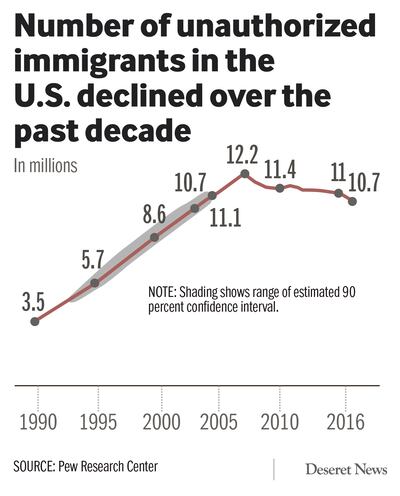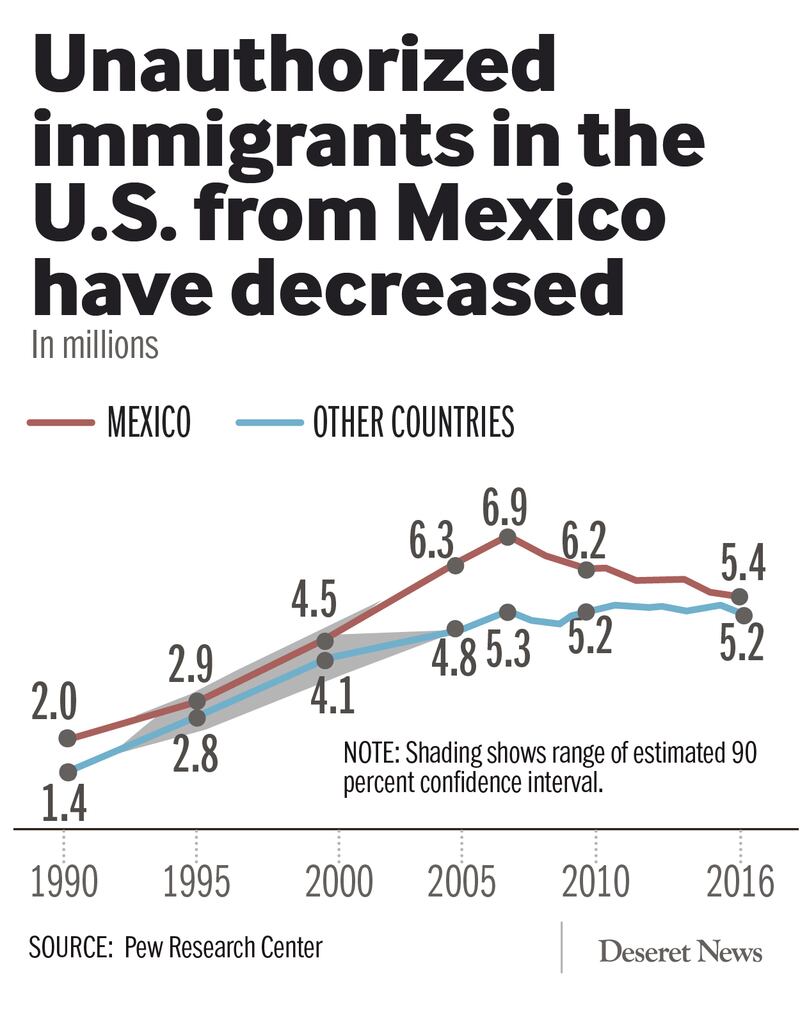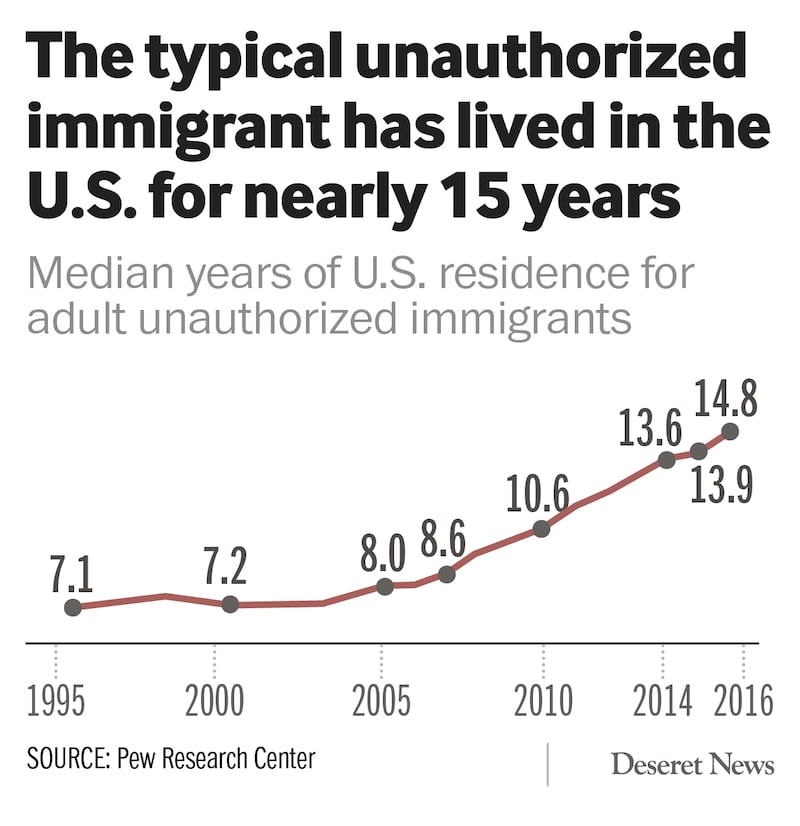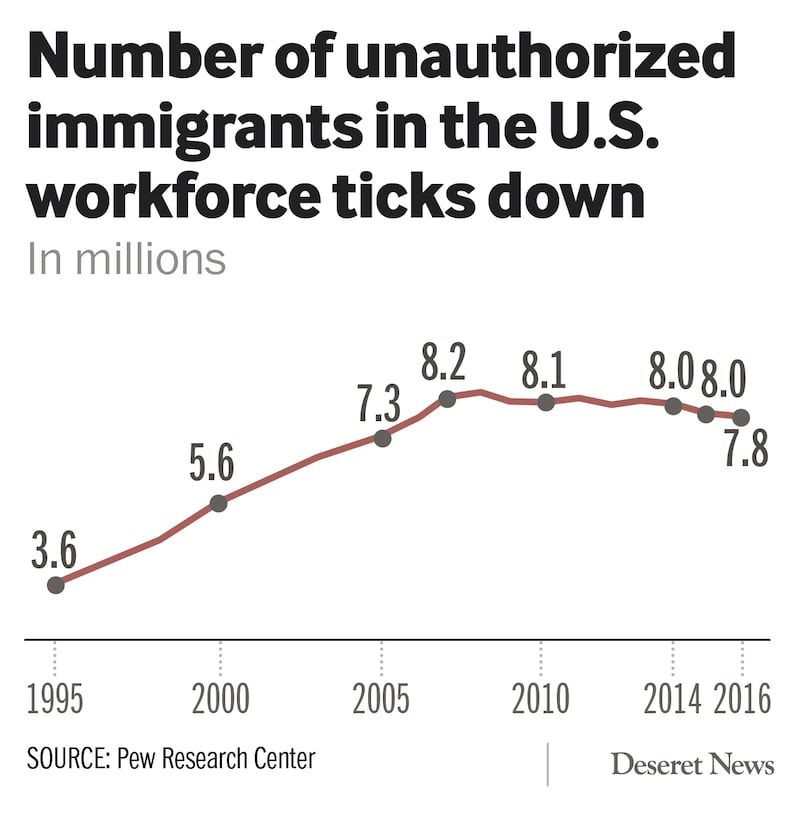SALT LAKE CITY — Just weeks after President Donald Trump declared the migrant caravan an "invasion" of undocumented immigrants, a new report finds the number of immigrants in the U.S. without legal status actually fell to its lowest level in more than a decade.
There were 10.7 million undocumented immigrants living in the U.S. in 2016, down from a peak of 12.2 million in 2007, according to new Pew Research Center estimates based on government data.
The decline is almost entirely due to a sharp decrease in the number of Mexicans entering the country without authorization, says Mark Hugo Lopez, Pew’s director of global migration and demography.
The decline in Mexican immigration isn’t a surprise, says Heide Castaneda, associate professor at the University of South Florida, as the numbers have been steadily falling for the last 10 years.

Economics played a major role in the decline, she said. There was a nosedive in Mexican migration in 2008 due to the recession, which wiped out millions of jobs that attracted undocumented immigrants to the United States.
“With the recession, there was just no draw of the U.S. job market, and the migration of low-wage workers since 2008 never fully recovered,” she said.
The Pew study showed that the number of undocumented immigrants working in the United States (7.8 million) and their share of the U.S. workforce (4.8 percent) fell steadily since their high points in 2007.
At the same time, the Mexican economy steadily improved, giving people from Mexico less of an incentive to migrate in the first place. Mexico’s changing demographics was also a factor, with an aging population resulting in fewer young people who might choose to migrate.
In fact, a 2015 Pew study concluded that more Mexicans returned to their home country between 2009-2014 than entered the United States, a historic shift.
As a result Central Americans represent a bigger share of recent arrivals to the U.S. Many travel through Mexico to seek asylum in the U.S., a trend most powerfully exemplified by the migrant caravan.
The number of unauthorized immigrants from Central America increased by 375,000 between 2007-2016, according to the study, mainly from El Salvador, Guatemala, and Honduras.

Mexico’s changing role — from a country that produces a high volume of migrants to a country that receives migrants — could change the relationship between the United States and Mexico, said Theresa Cardinal Brown, director of immigration and cross border policy at the Bipartisan Policy Center, a think tank based in Washington D.C.
Now, the United States will increasingly look to Mexico as a partner in solving complex regional immigration problems, such as how Mexico can improve its asylum system in order to be able to receive Central American asylum seekers, she says.
Such efforts are already underway, with Trump currently negotiating his “Remain in Mexico” deal with the just-inaugurated Mexican President Andrés Manuel López Obrador, in which asylum seekers would be required to wait in Mexico while their claims move through U.S. courts.
Here for the long haul
The slowdown in illegal immigration means that undocumented immigrants living in America are more likely to be long-term residents, rather than recent arrivals. Two-thirds of adult unauthorized immigrants have lived in the country for more than 10 years, according to the study.
The population of recent arrivals is shrinking: only 20 percent of all unauthorized immigrants in 2016 had arrived in the previous five years, compared with 32 percent in 2007.
The composition of the recent arrival population is different than one might expect, says Lopez.
Recently arrived unauthorized immigrants are less likely to have crossed the U.S.-Mexico border illegally, says Lopez. Rather, immigration experts believe it's likely that a bigger share of the unauthorized new arrival population are “overstays” — people who arrive in the United States with legal visas, but then overstay their required departure date.

Higher overstay rates “highlight a need for more interior enforcement” of U.S. immigration laws, says Matthew Sussis, assistant director of communications for the Center for Immigration Studies, a Washington, D.C.-based think tank that favors low immigration numbers.
But, Sussis says, that doesn’t mean the U.S. government should pare down border security efforts.
“The fact that overstay rates are high doesn’t mean you can ignore the border,” Sussis says. “Just because your back door is open doesn’t mean you can forget about keeping the front door closed too.”
Kids caught in the middle
The Pew study also focused on the children of undocumented immigrants, finding that about 5 million U.S.-born children under 18 live with unauthorized parents.
An undocumented immigrant of working age who came to the United States more than a decade ago is likely to have met someone and had children by now, said Castaneda. That results in what she calls “mixed-status” families, in which some members of household are undocumented and some are U.S. citizens.
Mixed status families are now a defining feature of contemporary immigration in the United States, according to Castaneda.

This means that families are being increasingly affected by the enforcement of U.S. immigration laws, Brown said.
“Enforcement efforts against the undocumented are increasingly impacting children and mixed-status families,” she said. “When you look at enforcement actions, you are impacting an entire household and an entire family structure.”
This can have devastating impacts on families, said Brown. Undocumented parents who are deported may have to choose between leaving their U.S. citizen children behind in the foster care system, or bringing their kids with them to countries where they may have difficulty adjusting — as they might not speak the language or be familiar with the local customs.
This is already happening, according to Brown. The deportation of undocumented adults is becoming a serious issue in Mexico right now, where the country is having difficulty integrating children of deported parents, some whom have limited Spanish language ability, into the Mexican school system, she said.
“The impact on kids is a large and growing concern, as you have a very solidly entrenched undocumented population in a time when enforcement actions are being stepped-up,” said Brown.
Overall, Brown said the findings of the Pew study may catalyze a re-evaluation of U.S. immigration policy.
“This is a fundamental change in what has been a decadeslong historical pattern,” she said. “As a result, we may have to rethink a major portion of our immigration system.”


